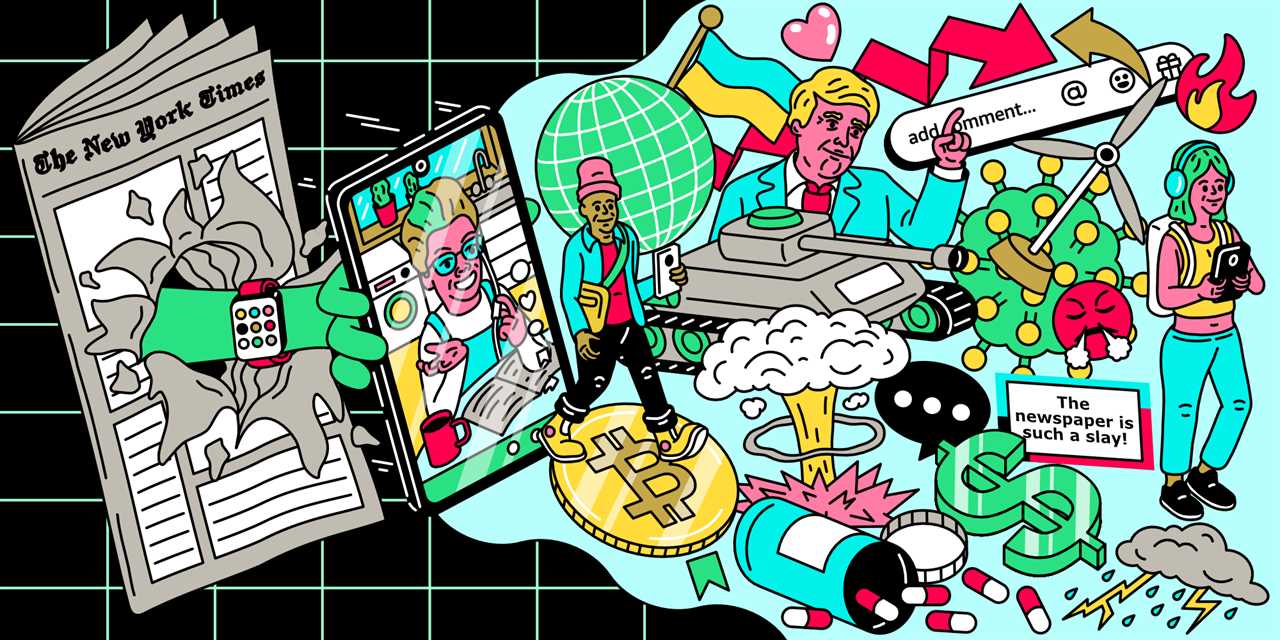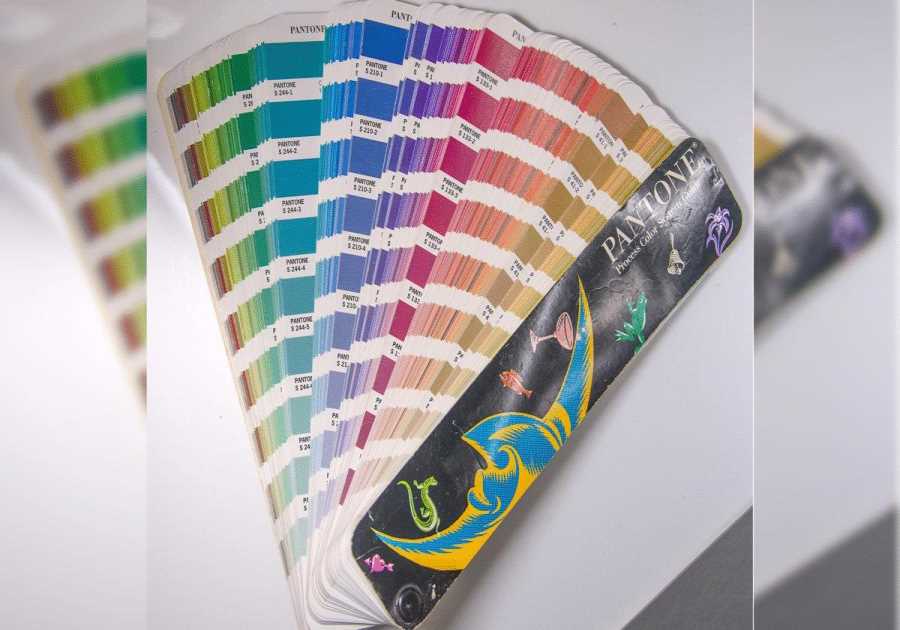
James Clapham for BI
Kelsey Russell, a 23-year-old TikToker in New York, is on a mission to pull off what media executives have struggled to do for decades: Persuade young people to buy newspapers.
The grad student posts several videos a week in which she flips through print pages of The New York Times, The Atlanta Journal-Constitution, and other legacy publishers to summarize stories. The broadsheets, blanketed with Russell's notes and highlights, are something of a nostalgic prop for her roughly 88,000 followers, some of whom may have watched their parents flip through physical papers but never touched one themselves.
Before finding a news niche, Russell spent years building a TikTok following by posting restaurant reviews and travel vlogs. Today she often blends her peppy commentary on news she thinks young people care about — such as healthcare and climate — with lifestyle content. In a November post, for example, she began by showing off her ribeye steak dinner, before diving into an Athens Banner-Herald article about criminal-justice reform.
"The newspaper is such a slay," a user commented on one of Russell's August videos where she talked about bombs in Syria.
Persuading young adults to pay for the news is a daunting task. Fourteen percent of US adults in a September survey from the Pew Research Center said they regularly get news from TikTok, up from 3% in 2020. Among 18- to 29-year-olds, that number jumped from 9% to 32%.
"News" on TikTok, however, rarely comes from mainstream outlets like The Washington Post or NBC News, both of which are trying to build audiences there. The app's recommendation algorithm rarely pushes users toward these accounts, an August study from researchers at Northwestern determined. "We find almost no evidence of proactive news exposure on TikTok's behalf," the study concludes.
Instead, young people on TikTok learn about what's happening from a hodgepodge of alternative sources, from commentary accounts like Russell's, to non-news influencers who occasionally dabble in current events when they enter the mainstream, to posts from people purporting to offer on-the-ground videos from breaking news events like a war or protest.
On TikTok's recommendation feed, there is little distinction between a report from ABC News and a rant about that report from a lifestyle influencer. That chaotic democratization is by design. A TikTok representative told Business Insider that the company treats all accounts the same when it comes to policing misinformation and promoting content.
What happens when a generation of Americans gets its news from an infinitely scrolling video app? What happens when the 24-hour news cycle collapses to a 24-second news cycle? In conversations with more than two dozen TikTok users, creators, researchers, and other media stakeholders, it became clear that Kelsey Russell filming herself flipping through the paper at her kitchen table is part of a paradigm shift. There are the high-stakes financial repercussions: TikTok's growing news influence could further batter an already severely wounded media industry. Then there's the potential dramatic effect on an informed republic. The app's ability to provide accurate information on current events is being tested in real time, with conflicts like the Israel-Hamas war stretching TikTok's content-moderation bandwidth.
"Platforms don't seem to be that interested in making a space for news," said Nick Hagar, a coauthor of the Northwestern report who now works as a data scientist at The New York Times. This "new dynamic," he said, is "going to impact what people see and what people think of as important."
Influencers read the news so their followers don't have to
One of the core pillars of TikTok's news ecosystem is what you might call the "news influencer" — creators like Russell who distill and interpret the news for their followers.
Though they're usually not affiliated with the outlets they talk about, these people may actually serve as better spokespeople for the industry than journalists at traditional publications. Some users told BI they found TikTokers more authentic and relatable than journalists, whom they believed had built-in biases tied to politics or corporate owners.
"I really liked this idea of somebody who's a generalist giving me my news rather than somebody who's always a specialist," said Tejas Sekhar, a 24-year-old medical student in Chicago. "I feel like sometimes that hits closer to home in terms of what I can glean from it that's relevant to my personal or daily life."
Any TikToker who is doing news communication has to have respect for traditional media.Vitus "V" Spehar
"What I'm providing people is a near-peer model of education," said Russell, who wants to parlay her master's in sociology and education policy into a job that mixes entertainment with media literacy (much like what she does on TikTok today). "Somebody that looks like you, that talks like you, that acts like you, that is around your age, is able to explain a topic that you might not be able to understand."
The share of US adults under 30 in Pew surveys who said they trusted information from national news outlets fell to 56% in 2022 from 62% in 2016, with trust in local news outlets falling to 62% from 71%. By contrast, trust in information from social media rose to 50% from 44%.
Traditional media brands that have been successful on TikTok often build their videos through individual reporter personalities. The Washington Post's Dave Jorgensen, for example, did an entire video series around working from his apartment during a pandemic, while Jack Corbett of "Planet Money" also filmed TikToks at his home using a bedsheet as a green screen.
For TikTok's emerging class of news influencers who have created their own niche, reading traditional media is still very much a part of their daily habits, even if it's absent from some of their followers' media diets.
With 3 million followers, Vitus "V" Spehar's @underthedesknews account is particularly effective at bridging the divide between traditional media and TikTok news. The 41-year-old describes their role on TikTok as a news communicator and civics explainer — a blend of Stephen Colbert, an after-school special on PBS, and "Schoolhouse Rock!"
Spehar's videos often include screengrabs from news articles to help credit sources when talking about topics like Sam Altman's temporary ousting from OpenAI or a House ethics report on Rep. George Santos. Spehar says they monitor anywhere from 12 to 15 news sources with the goal of finding stories that haven't become oversaturated.
A.B. Burns-Tucker, a 34-year-old recent law-school grad, has a similar approach to her legal commentary account @iamlegallyhype. She broke into TikTok news after posting a video in which she tried to explain what was happening in the Russia-Ukraine war to her followers as if she were talking to friends. The video took off, and she now walks through topics like an Israel-Hamas cease-fire or Mike Johnson's election as House speaker to an audience of about 700,000 followers.
"Your post is the only way I fully understand what's happening," one user commented on her October video about the Israel-Hamas war.
"Translators like you are so important," another user wrote.
Burns-Tucker, like Spehar and Russell, leans on professional news outlets for sourcing, even if her videos make it seem as if she's speaking off-the-cuff.
"Any TikToker who is doing news communication has to have respect for traditional media," said Spehar, who has done freelance work on TikTok for outlets like The Washington Post and the Los Angeles Times. "You don't have to like all of it. But you've got to find one piece that you do like and recognize that that is what's giving you power."
Not all TikTok news influencers cite their sources, of course. As has long been the case with other platforms, sensational retellings of the news that omit sourcing details are often the most popular.
"Welcome to ridiculous shit going on around the world right now," a TikTok creator named David Justinn with about 9 million followers said in a late-2020 video. "A frozen dragon was just discovered in Canada," he notes. The video garnered about 31 million views and about 6 million "likes."
And on hot-button issues like the Israel-Hamas war, for example, some creators have felt pressured to offer opinions on the matter even if they lack expertise, leading some to distrust information from the app.
Even though Pew's research showed that US adults broadly distrust information found on social media, TikTok faces an uphill battle given its resonance with younger adults who are more inclined to trust social apps. The company said it enlists fact-checking partners globally to help verify claims about misinformation. But other social apps have had similar partners and have failed, sometimes spectacularly and dangerously, to serve as effective news conduits. A 2020 Pew report found that US consumers who turned to social media for news tended to be less informed on topics like politics or the COVID-19 pandemic than their counterparts who engaged with traditional media like radio or news websites.
"I am worried and have a fear that the fragmentation that we see is going to cause problems for the body politic. That maybe people will pay less attention to politics and to traditional news and go off into their own corners on their own 'For You' page," said Gerry Lanosga, the director of the journalism program at Indiana University in Bloomington.
"To survive," he said, traditional media "has to be less traditional, of course, but needs to figure out a way to find inroads into these platforms, exist on them, and even thrive in them by making news products that are more obtrusive to people and interesting."
Some prefer TikTok news that cuts out influencers and traditional media entirely
Some users steer clear of news commentary altogether, preferring to get information from on-the-ground, "citizen journalism" footage of live events or firsthand testimonials. These videos, which can be difficult for a casual TikToker to authenticate, are nevertheless often viewed as more genuine or authentic than information delivered by a traditional journalist.
"Being able to see into someone's day-to-day and having them tell a story does feel so much more trustworthy or real than something that feels so far away," said Sanya Chaudhry, a 25-year-old TikTok user in Toronto. If there's a way traditional media could make news "feel real," she continued, "like it's real people telling the stories on the ground, if they can find a way to make it more personable, maybe that's a way that more people can get engaged with it."
And challenging as these videos are to verify, some TikTok users told BI that they believed the app had built-in tools to keep bad actors in check. The app's community of users can turn to features like the comments section of videos, video stitching, and dueting to call out videos that contain misinformation, they said.
"There's this kind of peer policing community that exists within TikTok, especially for things that are related to social and political matters," Sekhar said. "Sometimes creators will call each other out and say, 'Hey, that's actually incorrect, because of this.'"
Other platforms such as Reddit and X, formerly Twitter, have leaned on community features to help identify misinformation, with mixed results. A Bloomberg review of X's "Community Notes" in November found that the feature struggled to keep up with a relentless volume of misinformation about Israel and Gaza, with moderators taking more than seven hours on average to append corrective notes to false posts. In social-media time, that may as well be seven years.
All the news that's fit to rizz: How the media industry can use TikTok
There is one form of traditional news media that TikTok is proving useful for, and it happens to be the type of journalism most crushed by the news industry's shift to digital: local journalism.
"TikTok is a better place for local stories than national because people log into social media to look at content specifically tailored for them," said Matt Shearer, a Boston-area reporter who helped launch WBZ NewsRadio's TikTok account. The company won a regional Edward R. Murrow Award for innovation based on its work on the app this year. "Any time I post a video about a small town in Massachusetts, everybody in that small town and the surrounding towns shares that," Shearer said.
Vibrant as TikTok's news ecosystem is, the app hasn't done much to help the news industry make money. Publishers aren't holding their breath.
"The only way that radio is going to continue to flourish is if you have programmers and news directors who are brave enough to innovate, and try something a little different," Shearer said. "Nothing should be formulaic."
Other radio hosts like iHeart's Jeffrey Ramsey in Denver or Shannon Burns in Canada told BI in November of last year that they had successfully used the app to draw in a broader audience.
But so far, these local journalists and a handful of savvy creators at national brands have been exceptions to the rule.
And as vibrant as TikTok's news ecosystem is, the app hasn't done much to help the news industry make money. Publishers aren't holding their breath that it will.
News has long been a major headache for platforms like Facebook and Instagram, and it's a uniquely controversial topic for TikTok, which has a China-based owner and is under immense scrutiny over the way it handles the flow of news and other information.
TikTok, which operates more like an entertainment platform akin to YouTube or Netflix than a social network like Facebook, can try to avoid some of the mistakes in news delivery that its predecessors flubbed. Ultimately, it may end up re-creating the same information bubbles that plagued social-media apps throughout the 2010s, but this time for Gen Z.
For news publishers, betting on the app as a source to make money would be a mistake, even as TikTok gobbles up more and more user attention time, said Brian Morrissey, who founded the media newsletter The Rebooting and was previously the president and editor in chief at Digiday.
Unlike Google or Facebook, where links to news sites can fuel publishers' ad revenue, linking is almost nonexistent on TikTok. It's a closed ecosystem with limited monetization options, and TikTok hasn't expressed any interest in prioritizing professional publishers. The company also usually doesn't pay publishers for their content, though it is testing an ad-revenue share program.
"The idea of depending on platforms for ad revenues is a nonstarter," Morrissey said. "The idea that these tech platforms will help news publishers in any way, shape, or form to me would be a ridiculous bet."
But persuading US teens who by one estimate spend an average of 4.8 hours a day on social media to log off of TikTok and go directly to a news website they increasingly distrust is also a long-shot bet.
Kelsey Russell's advice to the industry is to imitate what she and her TikTok peers have done intuitively: Make the news relatable. Like any TikToker's, her videos are drawing eyeballs away from the very news organizations she hopes to promote. But her approach could also offer a model for how those news organizations can win over the next generation of consumers.
"Any time that you can bring in the younger voice, you can bring them to the table, you can make them visible, that's what people want," Russell said. "You've got to meet the people where they are."
Dan Whateley is a senior media reporter at Business Insider covering TikTok and social media.
Read More
By: [email protected] (Dan Whateley)
Title: Gen Z is getting its news from TikTok — and that might be a good thing
Sourced From: www.businessinsider.com/gen-z-gets-news-from-tiktok-influencers-media-industry-2023-12
Published Date: Thu, 14 Dec 2023 11:02:01 +0000
.png)





